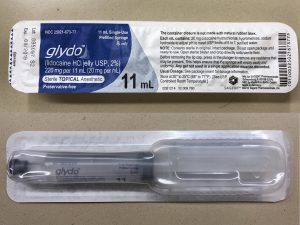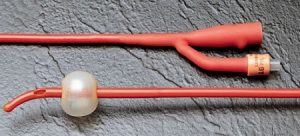A 57yo M presents with new onset urinary retention for 3 days. The triage nurse attempts to place a foley catheter but is unable to pass it. Bedside ultrasound confirms a distended bladder. The patient is now complaining of urethral discomfort and his urinary obstruction has still not been relieved. Ketorolac has minimally helped his pain, and he is refusing a repeat foley attempt without pain relief. In addition to (or instead of) systemic pain control for the next foley attempt, consider topical lidocaine. There are 2 ways to accomplish this while maintaining sterility.
Option 1: Uro-jet or Glydo, pictured below – topical 2% lidocaine jelly prepackaged in a sterile syringe. At Elmhurst, this can be ordered from pharmacy and tubed up to the ED. After cleaning/sterilizing, inject the topical lido into the urethra, and wait 2-3 minutes (while maintaining sterility – so don’t walk away) before inserting the foley.
Option 2: If no prepackaged sterile lidocaine jelly is available (keep in mind regular topical lidocaine jelly “for oral use” is NOT sterile), you can alternatively draw up standard injectable lidocaine 1 or 2% (~10 mL) and mix it with the sterile lube that comes in the foley kit. Then draw the mixture back up into the sterile syringe and apply to the urethra for the same effect.
Having learned that these options are available and not overly cumbersome to obtain, I now have a low threshold to offer this to every patient undergoing foley placement.
Also, if you’re at the step where a nurse has already tried and failed to insert a standard foley, it’s best to attempt with a coude tip foley, pictured here and stocked in the ED at both Sinai and Elmhurst:
Thank you Dr. Wong and Dr. Arjun Prabhu for the fodder for today’s pearl.


